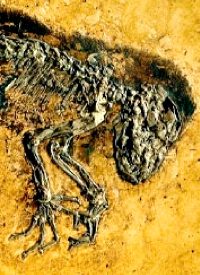
"Fossil Ida: extraordinary find is ‘missing link’ in human evolution," ran the Guardian headline on May 19. The media was abuzz with excitement over the find. As the website of New Scientist magazine pointed out in “Why Ida fossil is not the missing link,” even "Google’s homepage evolved, incorporating an image of the new fossil — nicknamed Ida — into the company’s logo.” The fossil was nicknamed Ida by the paleontologist from Oslo University who assembled the scientific team to study it, Dr. Jørn Hurum. The Guardian mentioned that “Hurum chose Ida’s nickname because the diminutive creature is at the equivalent stage of development as his six-year-old daughter,” who is, of course, named “Ida.”
As the Guardian tells the story, “Ida was originally discovered by an amateur fossil hunter in the summer of 1983 at Messel pit, a world renowned fossil site near Darmstadt in Germany. He kept it under wraps for over 20 years before deciding to sell it via a German fossil dealer called Thomas Perner. It was Perner who approached Hurum two years ago.” Hurum said, “I knew that the dealer had a world sensation in his hands. I could not sleep for 2 nights. I was just thinking about how to get this to an official museum so that it could be described and published for science.” While Hurum would not disclose the final price paid for the fossil, “the original asking price was $1 million.”
Strangely, according to the Guardian, Hurum “did not see the fossil before buying it — just three photographs, representing a huge gamble.” But he had a strong motivation to want the fossil to be authentic: “You need an icon or two in a museum to drag people in,” said Hurum. He believes "this is our Mona Lisa and it will be our Mona Lisa for the next 100 years.”
Quite a claim for something bought almost sight unseen, yet most of the media also bought into the hype. New Scientist brought things back down to earth: “Now that the first description of the fossil has been published, the task of sifting through the massive public relations campaign to understand the true significance of the new fossil can begin.” Ida does form “the basis for a new genus and species of adapiform primate, Darwinius massillae,” so named in honor of this year being the 200th anniversary of Charles Darwin’s birth. “The adapids are a branch of the primate tree that leads to modern lemurs.”
New Scientist goes on to ask: “What does Ida’s anatomy tell us about her place on the family tree of humans and other primates? The fact that she retains primitive features that commonly occurred among all early primates, such as simple incisors rather than a full-fledged toothcomb, indicates that Ida belongs somewhere closer to the base of the tree than living lemurs do. But this does not necessarily make Ida a close relative of anthropoids — the group of primates that includes monkeys, apes — and humans. In order to establish that connection, Ida would have to have anthropoid-like features that evolved after anthropoids split away from lemurs and other early primates. Here, alas, Ida fails miserably.”
So, in New Scientist’s final analysis, while “Ida is a remarkably complete specimen that promises to teach us a great deal about the biology of some of the earliest and least human-like of all known primates, the Eocene adapiforms,” the fossil “is not a ‘missing link’ — at least not between anthropoids and more primitive primates. Further study may reveal her to be a missing link between other species of Eocene adapiforms, but this hardly solidifies her status as the “eighth wonder of the world.’ ”
To this, the Institute for Creation Research online article entitled “ ‘Missing Link’ Ida Is Just Media Hype” adds a few more caveats. “First, the environment in which the fossil was kept for 20 years is unclear.” This is a long time for a scientific specimen to be kept in unknown conditions. “Second, the purchaser’s stated motivation for obtaining the fossil seemed to emphasize business over research.” Hurum was looking for a “Mona Lisa,” and this may mean that he needed to find one in order to turn a profit. And, “third, the fossil was hailed as humanity’s missing evolutionary link before the technical details of the find were published.” This appears to have been perfectly calculated to forestall any impartial analysis by the scientific community and intentionally designed to stir up media hype — which is exactly what happened.
The Institute concludes that Ida “will undoubtedly join the growing collection of fossils that were once thought to be missing links, but that upon further study turned out to be extinct creatures with no transitional features.”



